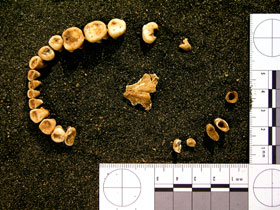  |
| HOME | THIS ISSUE | CALENDAR | GRANTS | BACK ISSUES | < BACK | NEXT > |
Researchers discover earliest signs of dental modification at Mexican burial siteby Michael Kirk - June 19, 2006 | ||||
|
A UConn professor and her team of fellow researchers have excavated an Archaic human burial site in Michoacán, Mexico, dated between 2570 B.C. and 2332 B.C., that is the oldest burial site discovered in that region of Mexico. The site includes the earliest known example of dental modification in the Americas. Anthropologist Tricia Gabany-Guerrero, an assistant professor-in-residence in the Division of Multicultural and International Affairs, says the burial was located under 12 feet of volcanic ash and a large boulder, which helped preserve the skeleton. The remains are of a healthy adult male between 28 and 32 years old, who was approximately 5 feet, 1 inch tall. The researchers determined the age of the remains based on four radiocarbon dates from bone and teeth. According to James Chatters, an archaeologist and paleontologist with AMEC Earth and Environmental Inc. in Seattle, Wash., and a member of the research team, the bottom row of the man’s teeth are worn to normal levels, but his upper front teeth were intentionally modified to accommodate a prosthesis, or denture, most likely for ceremonial purposes. “Dr. Chatters believes they intentionally filed the man’s teeth down to insert a ceremonial denture that would probably have been of animal origin, such as the palate of a wolf or jaguar,” says Gabany-Guerrero. “The teeth were filed down so much that their pulp cavities were exposed, leading to an infection.” Gabany-Guerrero, the team’s principal investigator, says dental modification was thought to be a later phenomenon. “During the Late Post Classic period, shortly before the Spanish came, we have seen evidence of insertion of turquoise and filed teeth in different forms,” she says. “But this is the earliest evidence of a dental modification by about 1,000 years.” The team began working at the site in 2000, discovered the man in 2003, and began analysis of the remains in 2005. Gabany-Guerrero and other members of the team are now at the site, where they will remain for much of the summer. She says they were led there by the elders of the local community, and would not have found it otherwise. “It is remarkable that we have found remains in a very remote area, and this leads us to believe that this region was much more important in the settlement of the early Americas,” she says. The local community named the man “Huitziniki” (pronounced “Wee-zee-neeki”), which translates loosely to “The Bald Man,” because of his bare skull.
The team found pieces of his skull and bones from his hands, legs, and feet, as well as his teeth. The remains do not indicate frequent, intensive exertion, but there is no indication of physical debility and he did not suffer from ailments such as arthritis. “The dental modification, apparent lack of strenuous activity, and the location of the burial in front of a cliff wall with extensive Archaic-style paintings indicate that the man held special status in late Archaic society,” says Chatters. The cause of his death is not known, but active infections of two teeth make blood poisoning a strong candidate. The researchers also found obsidian flakes buried with him. “The flakes were from a mountain located in the eastern Michoacán, very far from where he is buried,” Gabany-Guerrero says. “This indicates very early mining of obsidian and is some of the earliest evidence of obsidian flakes coming out of this area.” The research was largely funded by the National Geographic Society. The site is located near the Paricutin volcano in the Comunidad Indigena of Nuevo Parangaricutiro, surrounded by volcanoes and high mountain lakes. Rock art at the site has been tested using a portable XRF machine, which measures the elemental characteristics of paint. Through these studies, which are directed by Pedro Cid-Aguero, an assistant professor-in-residence of chemistry at UConn, the archaeologists are obtaining a better understanding of the techniques used in creating the red, black, and white paintings. The rock art motifs are consistent with several periods of occupation documented at the site from the Late Archaic Period to the Classic Period. According to Gabany-Guerrero, the Bald Man’s burial occurred right at the time when scientists believe the domestication of plants such as corn and squash was beginning in the Americas. |
| ADVANCE HOME UCONN HOME |

